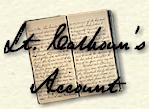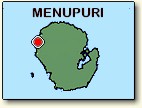|
1800 |
Units of
the 1st Bn, supported by 2nd Bn LMG plat and a 81 MM mortar platoon drove
the remaining organized Jap resistance on the beach at Warsa and Papriki,
and wiped it out. Many Jap officers were among the killed and captured,
but Col. Shimuzu has not been located yet. 84 Japs were killed or
captured, and we sustained 2 wounded. |
|
 Lt McCaffery
ordered me to take the 1st platoon to
Cape Aikar
which was a couple of miles to our west on the coast of the island. He
took the rest of the company on to Menupuri. A Jap defensive position was
reported to be at Cape Aikar. We hit the coast about a mile below the
village and had to locate it. After a patrol located it we moved quietly
back up to it. It was a large village with the thatched huts built on
stilts out over the water. A boardwalk led from the shore out to the
huts. We had to climb down cliffs to reach the village. This was about
1230 hr. As we cautiously approached the village we reached a point where
we were still concealed but had a good view of the village. About half a
dozen men came along the board walk from the huts to the shore. All were
in native attire except the lead man who wore Japanese Army trousers, a
U.S. Khaki shirt, a U.S. fatigue cap and carried a U.S. M-1 Carbine. He
drew our close scrutiny. Was he a Jap or a native? As he came closer it
became evident that he was a barefooted native. Another strange thing was
noted when we confronted them. There was no clip in his carbine. As we
approached the group they became very apprehensive and seemed ready to
break and run at the sight of our heavily armed platoon. We made friendly
signs, and the leader regained his courage. It was evident he was an
important chief. The Army did not give away carbines, even though empty,
to anyone who was not a VIP. “Nippon” had been here, but they had moved
up the coast. There was no evidence of a large group having been here, so
we thought a small group of stragglers had come by. They chief was
incensed that they had been stealing his papaya. Evidently there was a
garden nearby. He was so proud in showing off his carbine that he could
hardly contain himself. He kept saying “piggy”, raising his carbine, and
saying “bang! bang!” He and his entourage headed inland for the forest
evidently to hunt “piggies,” because as long as we could hear him he was
still yelling “piggy, bang! bang!” Lt McCaffery
ordered me to take the 1st platoon to
Cape Aikar
which was a couple of miles to our west on the coast of the island. He
took the rest of the company on to Menupuri. A Jap defensive position was
reported to be at Cape Aikar. We hit the coast about a mile below the
village and had to locate it. After a patrol located it we moved quietly
back up to it. It was a large village with the thatched huts built on
stilts out over the water. A boardwalk led from the shore out to the
huts. We had to climb down cliffs to reach the village. This was about
1230 hr. As we cautiously approached the village we reached a point where
we were still concealed but had a good view of the village. About half a
dozen men came along the board walk from the huts to the shore. All were
in native attire except the lead man who wore Japanese Army trousers, a
U.S. Khaki shirt, a U.S. fatigue cap and carried a U.S. M-1 Carbine. He
drew our close scrutiny. Was he a Jap or a native? As he came closer it
became evident that he was a barefooted native. Another strange thing was
noted when we confronted them. There was no clip in his carbine. As we
approached the group they became very apprehensive and seemed ready to
break and run at the sight of our heavily armed platoon. We made friendly
signs, and the leader regained his courage. It was evident he was an
important chief. The Army did not give away carbines, even though empty,
to anyone who was not a VIP. “Nippon” had been here, but they had moved
up the coast. There was no evidence of a large group having been here, so
we thought a small group of stragglers had come by. They chief was
incensed that they had been stealing his papaya. Evidently there was a
garden nearby. He was so proud in showing off his carbine that he could
hardly contain himself. He kept saying “piggy”, raising his carbine, and
saying “bang! bang!” He and his entourage headed inland for the forest
evidently to hunt “piggies,” because as long as we could hear him he was
still yelling “piggy, bang! bang!”
 After we were
satisfied that there were no organized Jap units in this area we started
for Menupuri. We were moving along the top of cliffs about 150-200 feet
tall. There was a narrow. dry reef at the base of the cliffs. At a bend
we could see a fairly large cave opening a few feet above the reefs. We
worked down a steep draw to the mouth of the cave. We approached this
opening with great caution. Just as we entered the cave all hell broke
loose. A horde of bats came out in a cloud that practically filled the
cave entrance. They kept pouring out in what seemed to be an unending
blanket. After some time they were all gone. Somewhat shaken we moved
along the reef. After a bit the tide started to rise, and we were soon
wadding in water several feet deep. The cliffs were sheer with no place
to scale them. After some time the cliffs receded gradually, and we were
able to climb up a low embankment to dry land. We went on into Menupuri
without further incident. We joined the rest of the company who had been
assigned the defense of an air warning unit. We were not placed on the
perimeter but within the perimeter as the reserve. We dug in where the
tents of the Army Airforce personnel were located. They had tents and a
regular mess. We had foxholes and K rations. After we were
satisfied that there were no organized Jap units in this area we started
for Menupuri. We were moving along the top of cliffs about 150-200 feet
tall. There was a narrow. dry reef at the base of the cliffs. At a bend
we could see a fairly large cave opening a few feet above the reefs. We
worked down a steep draw to the mouth of the cave. We approached this
opening with great caution. Just as we entered the cave all hell broke
loose. A horde of bats came out in a cloud that practically filled the
cave entrance. They kept pouring out in what seemed to be an unending
blanket. After some time they were all gone. Somewhat shaken we moved
along the reef. After a bit the tide started to rise, and we were soon
wadding in water several feet deep. The cliffs were sheer with no place
to scale them. After some time the cliffs receded gradually, and we were
able to climb up a low embankment to dry land. We went on into Menupuri
without further incident. We joined the rest of the company who had been
assigned the defense of an air warning unit. We were not placed on the
perimeter but within the perimeter as the reserve. We dug in where the
tents of the Army Airforce personnel were located. They had tents and a
regular mess. We had foxholes and K rations.
This
afternoon "A", "C", and part of "B" Companies were banzied by 70 Japs on
the coast east of us. The Japs obliged them by charging across the open
beach in what was a real banzai to end it all by dying for the Emperor.
Late this
afternoon a hard rain set in. The men of the AW unit let us, the 1st
platoon , come into their pyramidal tents. The mess sergeant even invited
us to eat with them. About 1900 I was ordered to report to the tent which
housed the 1st battalion headquarters. I was to move my platoon out
pronto to the north about a mile and a half. They were afraid any
remaining Japs would move north. We were to move to a trail intersection
and block any enemy movements. We were underway in a short time. It was
raining hard and pitch dark. They told me sound power wire was laid by
the trail. We followed the trail by holding on the wire and letting it
run through our hand. Each man held onto the back of the man’s belt in
front of him. The going was slow and laborious because of the slippery,
narrow, up and down trail. The projecting coral rocks caused much
stumbling and cursing. After slipping and sliding for a long, long time
we began a long, steep ascent. When we got to the ridge top we felt this
had to be the tall hill overlooking the trail junction. We placed the men
along the ridge by feel. Then we sat under our ponchos, soaked to the
skin, in a driving rain, with a brisk wind blowing, and thought we were
freezing to death. We could hear teeth chattering above the wind and rain
noise. We had been so smug in the AW’s tents back at Menupuri while the
rest of the company endured the rain in their foxhole back at Menupuri.
We’d give anything to change with them now.
|


